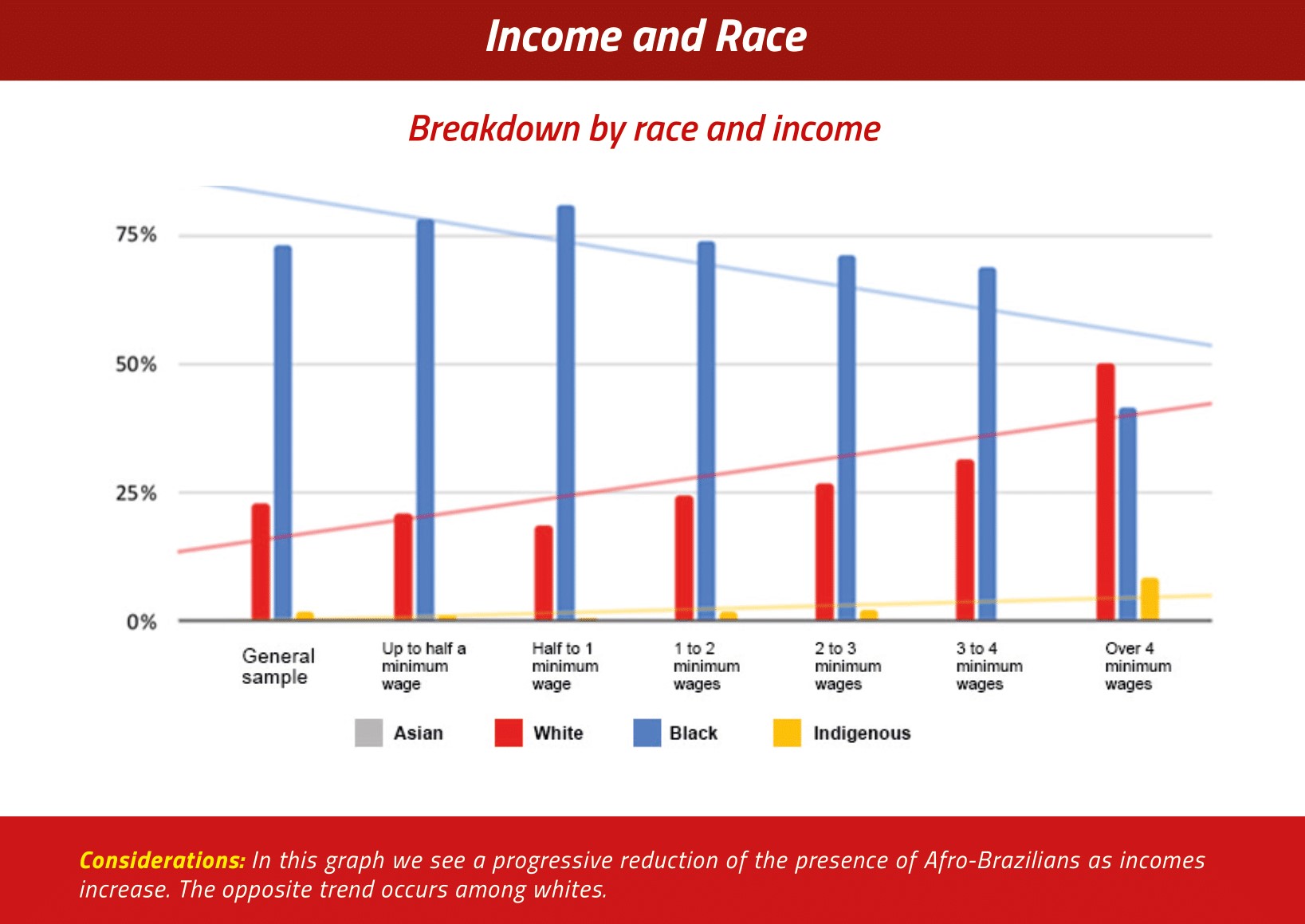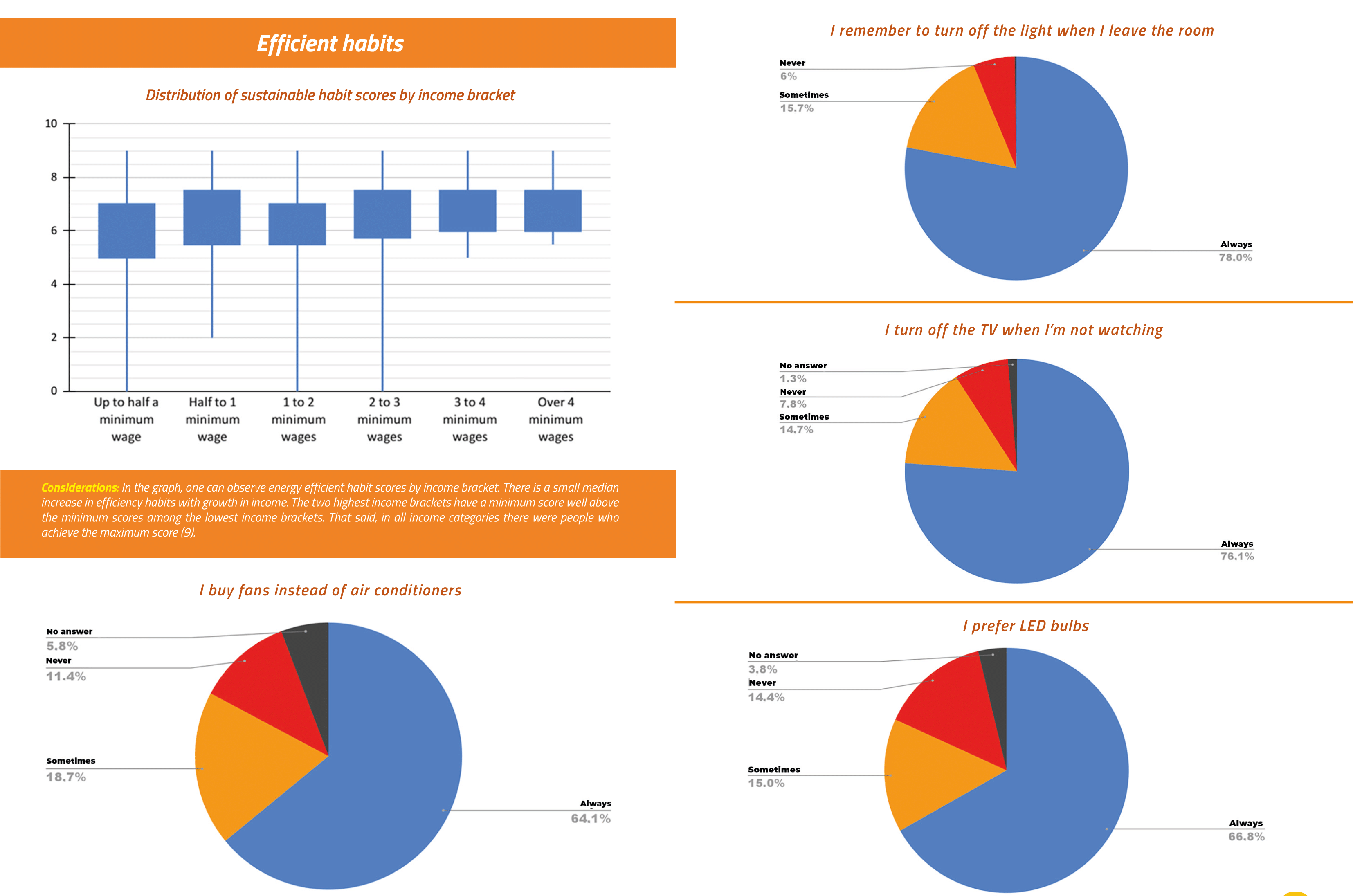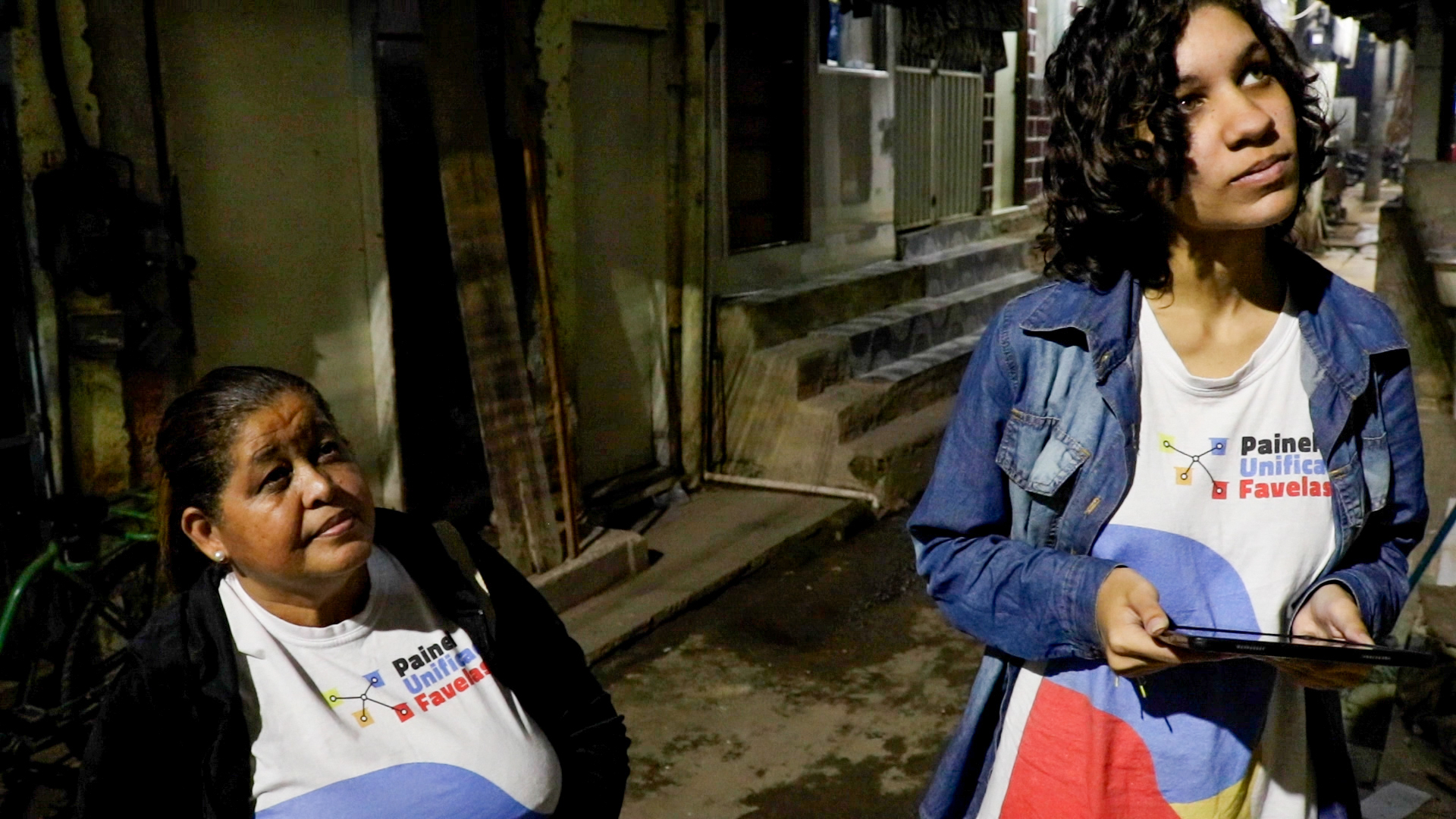
Clique aqui para Português
The collectives responsible for the Covid-19 in Favelas Unified Dashboard and the report Water and Energy Justice in the Favelas: Community Researchers Gather Data Revealing Inequalities and Calling for Action launch a specific report analyzing the impacts of energy (in)efficiency across 15 favela communities in Greater Rio de Janeiro. Access images here. Access the report here.
April 20, 2023 — In preparation for Earth Day (April 22), Rio de Janeiro’s Sustainable Favela Network (SFN) and the Favelas Unified Dashboard (PUF)* launched the report Energy Efficiency in the Favelas.
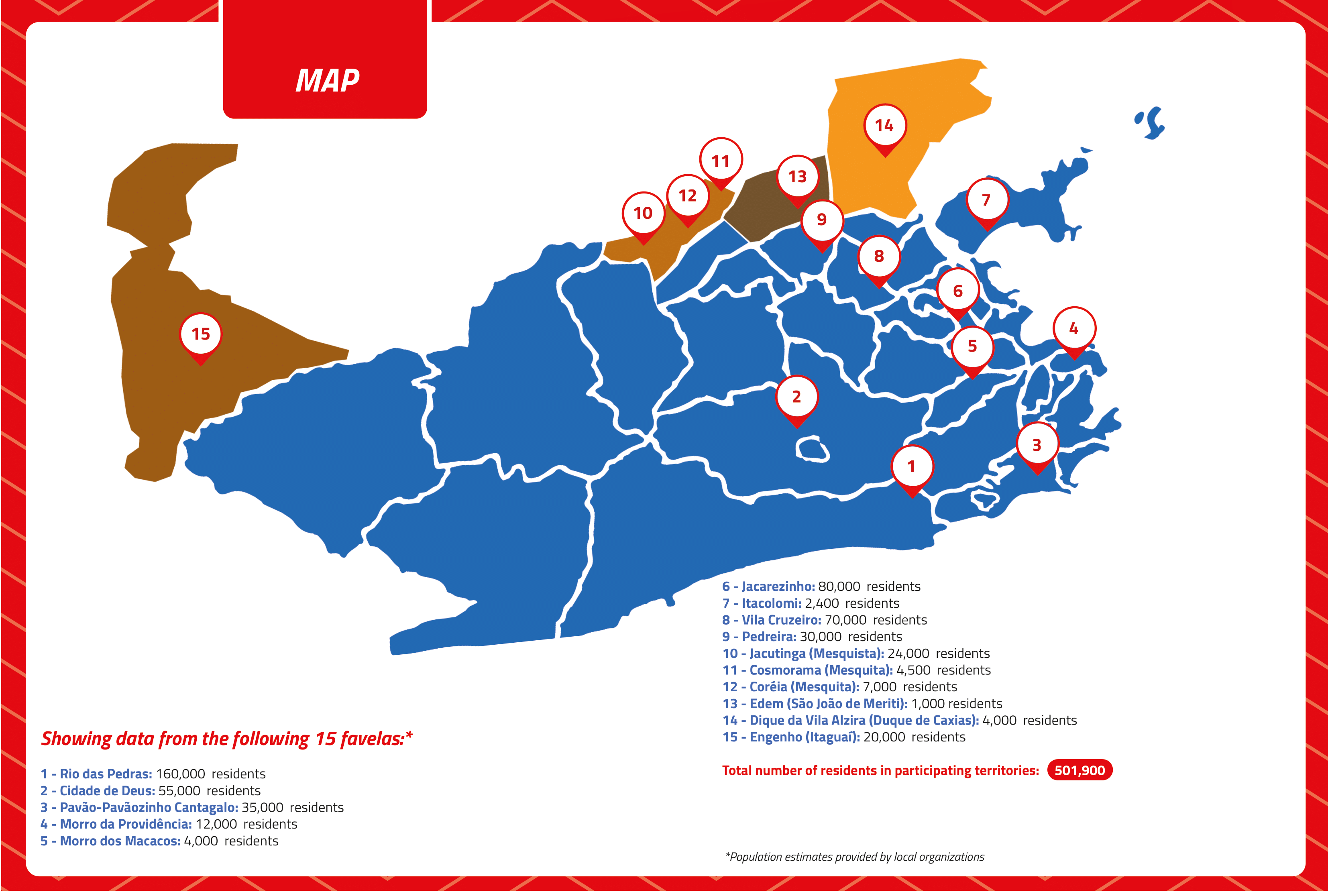
Last year, the SFN, PUF, and seven partner institutions** realized the course and research project, “Monitoring Water and Energy Justice in the Favelas.” The course was held while the Brazilian Institute for Geography and Statistics (IBGE) was holding Brazil’s national census, following over a decade without officially updating national data. The course and resulting research engaged 45 youth and leaders from 15 favelas in Greater Rio as citizen-researchers, proving that favelas can produce robust data, in many ways producing a more complete picture than researchers from outside these territories.
Following the launch of the acclaimed research project report Water and Energy Justice in the Favelas: Community Researchers Gather Data Revealing Inequalities and Calling for Action—released in September 2022, with coverage in Globo TV, CNN, Agência Brasil, and Notícia Preta—participants turned their attention to more in-depth and detailed analyses of their data. One outcome is the new report launched today.
Unprecedented Data on Energy Efficiency in Rio’s Favelas
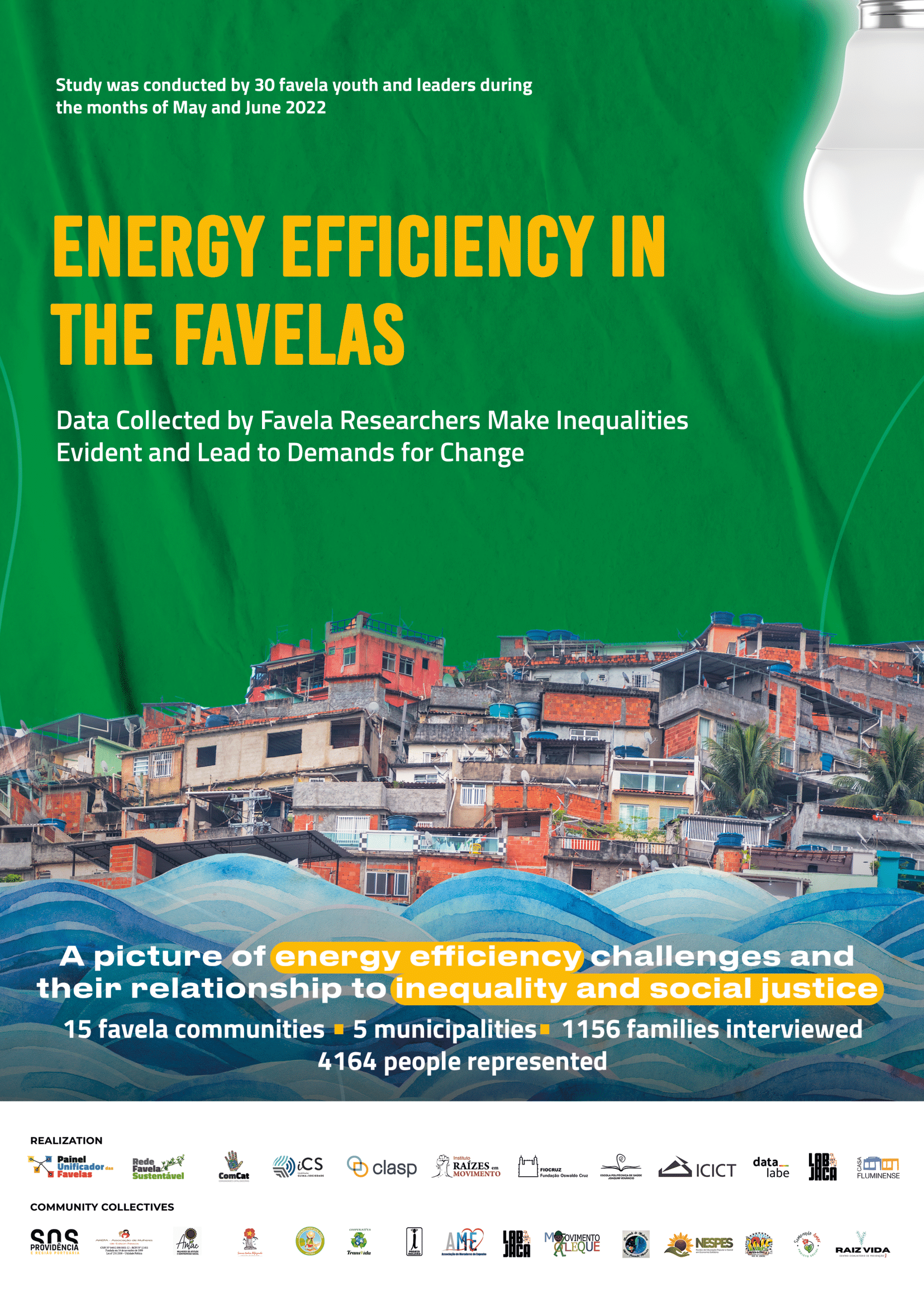
The data presented in the new report Energy Efficiency in the Favelas reflect the reality of 1,156 families (4,164 people) in 15 favelas from five municipalities across the Greater Rio metropolitan region, and specifically show the relationship between energy, poverty, and social inequality, focusing on the efficiency of service provision and use. The wealth of information produced by this analysis was striking even to those involved.
Kayo Moura, a social scientist, student of statistics and member of the data and narratives laboratory, LabJaca, based in the Jacarezinho favela and recently referenced in The New York Times, was responsible for the analysis. He explains:
“My background is not directly related to environmentalism and sustainability, which is why I thought energy efficiency was an issue that didn’t really involve me. The most interesting thing [about this study]… was understanding that when we talk about energy efficiency in the favelas, urban peripheries, and the Global South, we are talking about justice, about access. If I had to define the report in one statement, it would be that: energy inefficiency operates as a tool of energy injustice, especially in Brazil’s favelas.
Inside favelas, with a majority of families left socially vulnerable, inefficiency affects the poorest of the poorest. It is those with the least knowledge of their rights, such as about the Social Electricity Tariff, that suffer the most from service inefficiency and endure the most frequent and longest blackouts.”
By digging into the data on energy poverty and its consequences, about inefficient appliances as a default, as well as the prevalence of efficient habits among favela residents—an uncoered fact which contradict society’s stereotypes—among other findings, options are presented to public officials to integrante into policy-making, proposals to help vulnerable families be more energy efficient, either through improving access to energy-efficient appliances or discounts.
The Backdrop of Poverty and Racial Inequality
Energy Efficiency in the Favelas presents the data within their socioeconomic context, making income comparisons. For example, of the 4,163 residents represented in the data, 15% live on up to half a minimum wage and 36.8% between half and one minimum wage. Thus, slightly over 50% of individuals represented in the study earn a monthly family income of up to one minimum wage. This means that over half the families interviewed live below the poverty line.
When the analysis turned to racial breakdown by income bracket, there was a clear inverse correlation between race and income. Even in these favelas, a smaller proportion of Black people were present in higher income groups. The sample taken inside favelas reflects the broader societal trend of Afro-Brazilians being overrepresented in lower income brackets.
Energy Poverty and its Brutal Consequences
An important concept to be included in the public debate on access to basic services in Brazil is that of energy poverty, which refers to when an electric bill takes up over 10% of a family’s monthly income (the recommended is below 6.8%). The new report shows that families earning zero to half a minimum wage make up the majority of families facing energy poverty. There is a trend line: as the income bracket increases, the proportion of families facing energy poverty decreases.
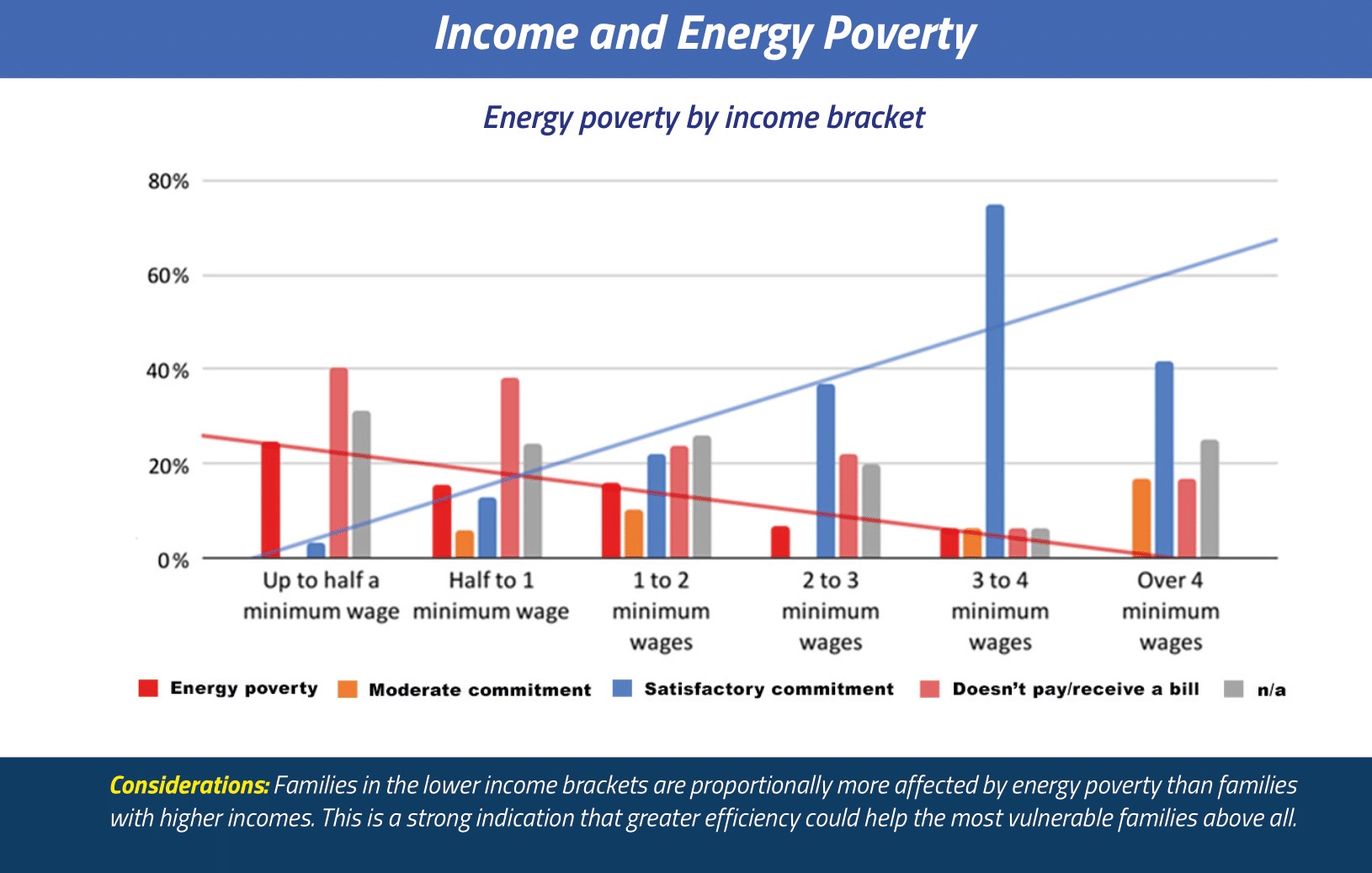
Meanwhile, 69% of respondents stated that if their electric bill were halved, they would use the money to buy food (instead of paying other bills, buying medication, for education, etc.), which indicates that energy poverty is directly linked to food insecurity for interviewees.
Energy poverty also leads to meeting the need for electricity and everything it provides (from powering water pumps in order to access water to the ability to access information and employment opportunities through cell phones) in other ways. As Moura explains:
“The approach we used when studying ‘gatos’ [clandestine electrical connections] was from the perspective of understanding the need to guarantee access, rather than criminalize access. The data show how ‘gatos’ are frequently the only means by which people can access energy. The poorest families, earning up to half a minimum wage, are shown to have the biggest proportion of ‘gatos.’ As income increases, the proportion of those who state they do not have a ‘gato’ also increases. So we see how this is a question of access, of being in a financial position to pay the electric bill, and not one of dishonesty or taking advantage.”
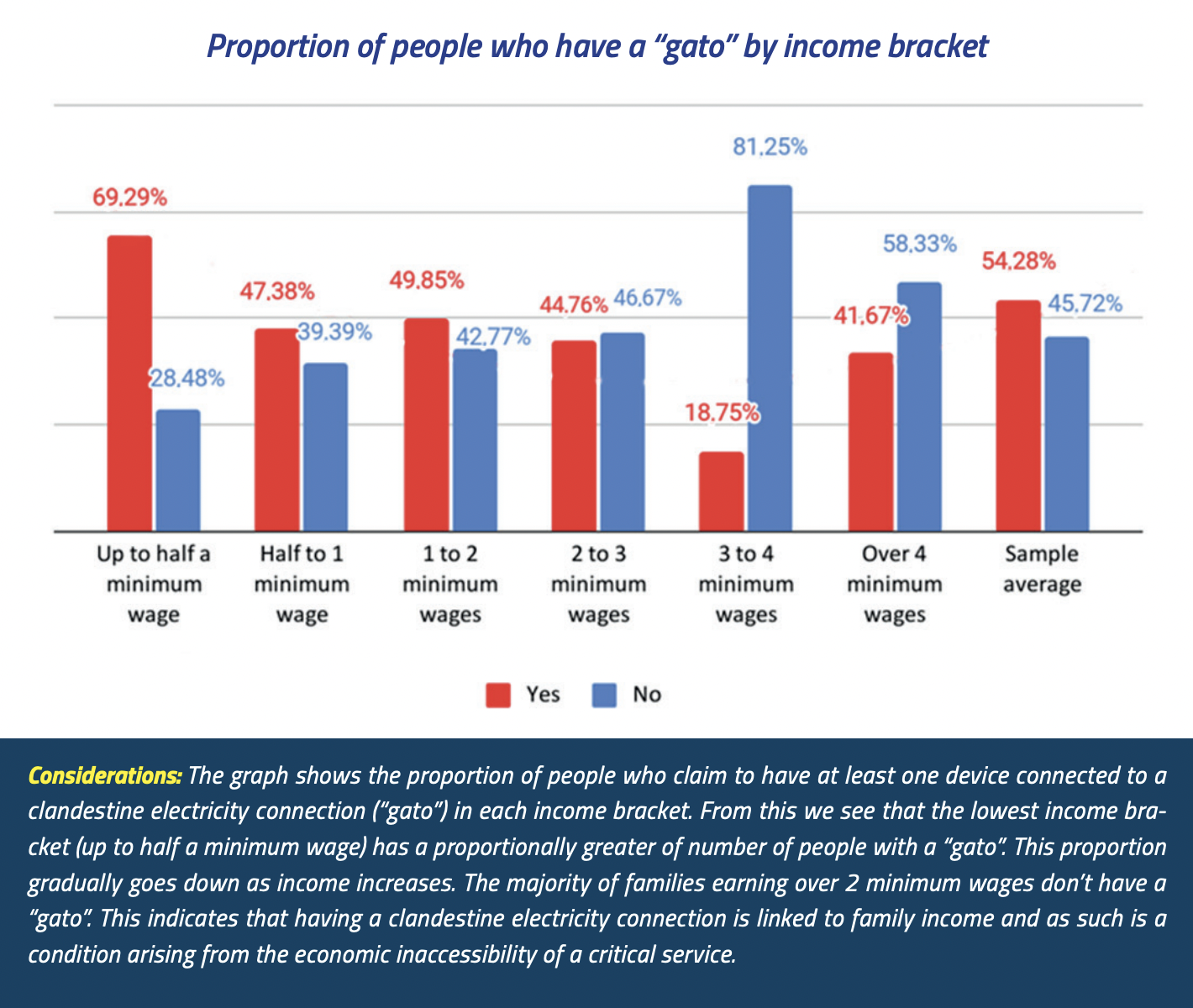
The consequence of depending on the irregular connection of a “gato” is inefficiency of access to the service and its repair, which further reinforces the poverty of the family that depends on it. The families with the lowest incomes in the study were those that suffered most from service inefficiency. Moura provides another excellent summary of the results:
“Those who said they faced daily blackouts are in the income brackets of up to half a minimum wage. When we asked about blackouts that lasted over 24 hours in the past three months, this is once again evident. As the income bracket increases, the number of people stating they did not face a blackout that lasted over 24 hours in the past three months also increases.
We also saw that the most socially vulnerable people are the ones with the weakest consumer relationship with the utility, Light. Service inefficiency once again penalizes the poorest, who for a whole host of reasons are unable to access the utility to demand what is their right.”
The negligence, however, also occurs for those who have an electric meter and should have a direct relationship with Light. As described by a youth researcher in the case of a resident in his community of Mesquita:
“The utilities do everything their way, when they want to [when it comes to the favelas]. There was even a case of a lady where they simply came, pulled out her electric meter, and gave no reason. And the bill continues to come, even without the meter.”
Inefficient Appliances Due to Lack of Choice and Information
Typically, when we think of energy efficiency, we envision household appliances that can do more with the same amount of electricity, resulting in cost and energy savings. The research aimed to understand whether favela residents who participated in the study have access to efficient appliances, which they use, and what kinds of appliances have the largest impact on their electric bills.
Based on the aforementioned results highlighting the vulnerability of lower-income families, obtaining information about energy-efficient appliances that could potentially reduce electricity bills is equally challenging for them. These were the same families with the greatest proportion of those without knowledge about the National Energy Conservation Label (ENCE), a mandatory label affixed to all electrical appliances in Brazil, which indicates their energy usage in comparison to other appliances. Furthermore, qualitative accounts obtained during the study revealed that energy-efficient appliances, often the latest models and expensive, are furthermore inaccessible to residents who lose appliances due to recurring blackouts and have to replace them regularly with second-hand ones.
In order to understand the technical aspect of energy efficiency, the study focused on key household appliances (air conditioners, electric showers, refrigerators, washing machines, televisions, and fans) and calculated the estimated impact of each appliance’s energy consumption on a family’s monthly income. The research confirmed that air conditioners are the ‘big villain’ in terms of electricity consumption and its impact on the household budget, despite being a blessing on hot days. Among all the appliances, air conditioners have the highest impact, accounting for 51.4% of total consumption, surpassing the combined impact of electric showers, refrigerators, washing machines, televisions, and fans. Over 50% of those interviewed reported owning between one and three air conditioners.
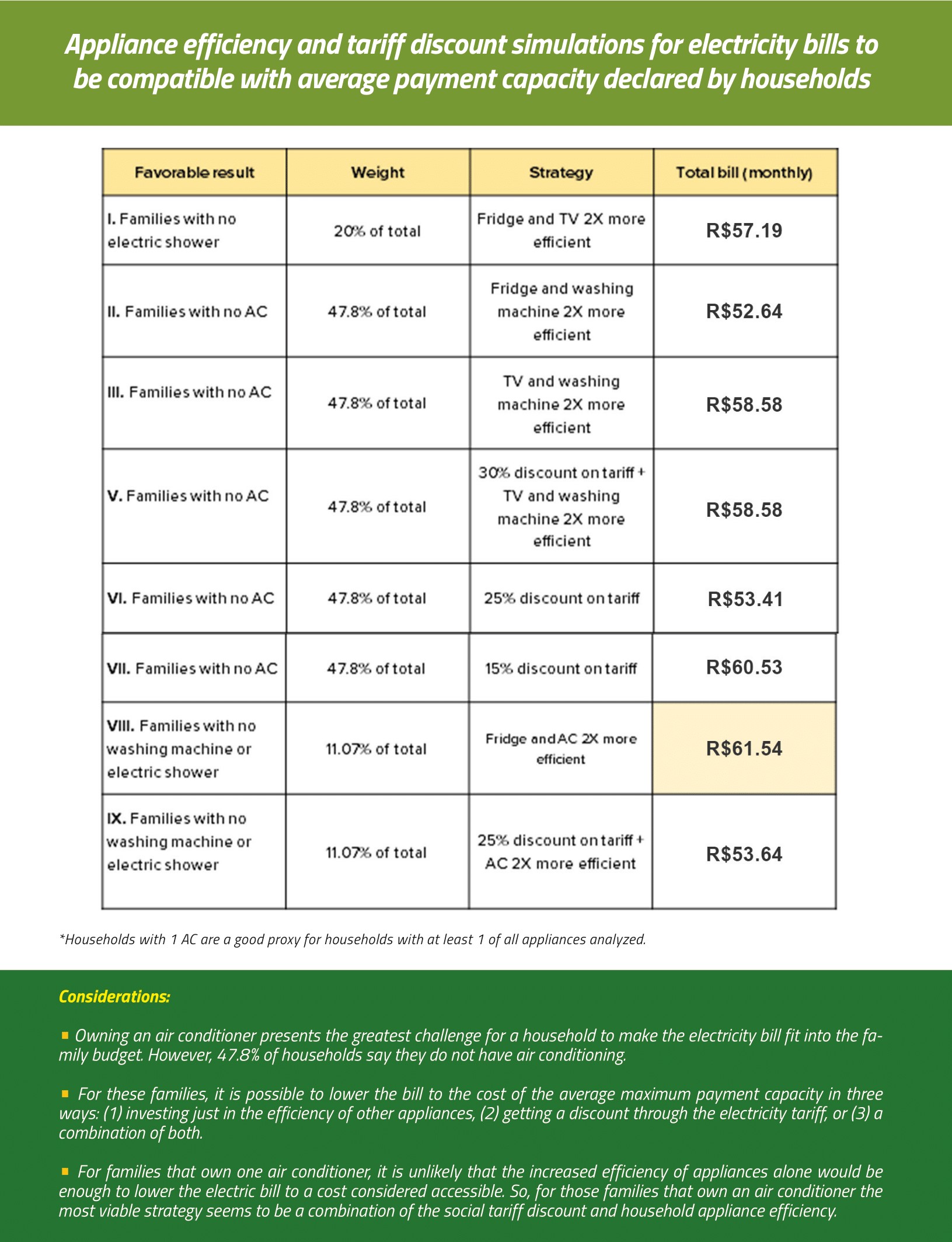
According to Moura, this part of the survey was conducted to assist authorities and professionals in thinking of ways to help families achieve more efficient average energy consumption: “While it may not be feasible to produce an air conditioner that is three times more efficient, could it be possible to implement a social tariff that offers a 25% discount to families that meet a specific criterion and use air conditioning, for example?”
Efficient Habits Independent of Clandestine Access
There are two main strategies for achieving efficient energy use. The first is to invest in efficient appliances, which, as demonstrated, is not very accessible to favela residents due to high cost and lack of information. But the second is more attainable as it relates to the human aspect: consumer habits.
The study posed various questions to understand efficient habits by consumers, such as remembering to turn off lights when leaving a room or the use of LED bulbs. Based on the responses, a point system was devised, attributing one point to every response that represented a high degree of energy efficiency, with the highest score being 9. The results show a high degree of concern about maintaining efficient habits: over half of interviewees scored between 6 and 9, and many showed concern with having energy efficient habits without even knowing the term.
Moura summarizes:
“There’s a myth whereby many people believe that no one in the favela cares about energy-saving habits. There’s also a misconception that everyone in the favela has a ‘gato’ [clandestine electric connection] and that since they don’t pay for electricity, they don’t care about savings or energy efficiency. We compared the behaviors of people who have a ‘gato’ and those who don’t. We discovered that there is a small difference between those who have a ‘gato’ and those who don’t, but that it’s negligible, indicating that, in general, regardless of whether a person has a ‘gato’ or not, residents tend to seek energy efficiency in what is in their power: their habits.”
Authorities Fail to Guarantee Access to Social Tariff
The study conducted by 45 favela youth and leaders, who personally defined its indicators, incorporated questions aimed at presenting and identifying knowledge among their neighbors about the Social Electricity Tariff (TSEE) in addition to the ENCE label. The Social Tariff offers discounts on electric bills to those who most need them and also provides rewards for energy savings: the more efficient the consumer is, the larger the discount. Both are mechanisms already in existence that aim, in theory, to make bills cheaper for families with the greatest need.
Unfortunately, as with the ENCE label, there is a significant lack of knowledge about the Social Tariff. This was seen in all income brackets during the study. And this lack of knowledge is even larger, over 75%, in the lowest income groups, which have the greatest need and right to benefit from the TSEE. Approximately 60% of all families in the study meet the income criteria for the TSEE, but only 8% state that they receive the benefit. Of the families that meet income criteria to qualify for the TSEE, 90% say they do not receive the benefit.
Despite Constant Exclusion, Favelas Embody Potential
Energy Efficiency in the Favelas is the second report to emerge from the ‘Monitoring Energy and Water Justice in the Favelas’ research course during which 45 youth and leaders from 15 favelas built a robust study that has generated unprecedented findings. Additional reports will follow, presenting data by region for example, and further analyses are welcome.
Moura explains:
“The project and research will continue. It was an extremely powerful study with a collectively created methodology and the outcome of a research course developed by favela networks. The most exciting aspect of the report is that it raises various questions about energy efficiency, energy justice, and other related issues from different angles. Keep in touch with the Sustainable Favela Network to learn about future steps.”
Concluding, he continues:
“The time it takes for power to be restored [after a blackout] and the lack of overall assistance are the result of a historical process: the selective absence of the State. Yes, the State shows up in the favela, but mostly just through the police. That is why narrative is so important. People from outside often see the favela as a problem, which is why the study we’ve conducted is crucial: it’s by the favela, for the favela. We are no longer objects of study; we are building our own narrative from the inside out, producing discourse about ourselves. There’s no way of thinking and talking about the favela without us being there as the main actors, as subjects. We’re here telling our own story. It’s no longer someone else telling it from the outside. This is why electricity is important, because the lack of electricity also means the lack of means of communication. And we’ve got to resist, we’ve got to fight so we can speak for ourselves, so we can tell our own story. The story of Brazil from our point of view.”
HIGHLIGHTS FROM THE DATA
Efficiency and Quality of Access
- 55.2% of people represented in the research are living below the poverty line, with a per capita monthly family income of up to R$497 (US$96).
- 41.5% of families earning up to half the minimum wage experienced blackouts lasting over 24 hours in the past three months. Among families earning 2-3 minimum wages, the percentage was 23%. 32.1% of families have experienced loss of electrical appliances due to electrical grid failures.
- Families pay, on average, an electricity bill that is twice their average payment capacity. 31% of families experience energy poverty, with a disproportionate amount of the family budget going to pay the electric bill.
- 69% would choose to spend the savings on food if their electric bills were reduced.
- The poorest families, earning up to half a minimum wage, are shown to have the biggest proportion of clandestine connections. As income increases, the proportion of those who state they do not have a clandestine connection also increases.
- 68.7% of those interviewed (794 people) do not know what the Social Electricity Tariff (TSEE) is. 59.55% of families meet the income criteria to qualify for the Social Tariff, but only 8.04% of families state they receive the benefit, while 90.04% of families who would qualify affirm they do not receive it.
- 73% of families earning up to half a minimum wage state they do not complain or make requests to the utility, Light. As income increases, comfort in requesting services from the utility increases: only 33% of those earning over four minimum wages say they do not make complaints to Light.
Energy-Efficient Appliances and Habits
- Air conditioning is responsible for over half (51.4%) of energy consumption in the sample, followed by electric showers (13.8%) and refrigerators (13.6%).
- Energy-saving habits are at a good level across the sample population. The average score was 6.21 and the mode was 7, with the scale ranging from 0 to 9. Among those interviewed, 78% always remember to turn off the lights when leaving a room and 67% choose LED bulbs.
- 50.6% state they know what the National Energy Conservation Label (ENCE) means. Of those that know the label, 49.1% state they have bought an electrical appliance based on it being classified in the ENCE A category.
RESOURCES AND PRESS CONTACT
Links:
- Report in Portuguese
- Report in English
- Images for use. Credit: Favelas Unified Dashboard
- Video for use. Credit: Favelas Unified Dashboard
- Documentary for use. Credit: Favelas Unified Dashboard
Contact:
- Email: press@catcomm.org
- WhatsApp +55-21-991976444
*The Sustainable Favela Network (SFN), Favelas Unified Dashboard, and RioOnWatch are initiatives of the NGO Catalytic Communities (CatComm). The course “Researching and Monitoring Water and Energy Justice in the Favelas,” was carried out collaboratively by the following organizations: Roots in Movement, ICICT and EPSJV (Fiocruz), Climate and Society Institute, CLASP, LabJaca, DataLabe, and Casa Fluminense.
**The community organizations which took part in the course and research project were: Alfazendo (City of God/Rio de Janeiro), Fusion Social Center Association (Jacutinga/Mesquita), Women of Attitude and Social Commitment Association (Dique da Vila Alzira/Duque de Caxias), Edson Passos Women’s Association (Cosmorama/Mesquita), Association of Itaguaí Warrior Women and Social Organizers (Engenho/Itaguaí), Life Root Community Center (Morro dos Macacos/Rio de Janeiro), Transvida Cooperative (Vila Cruzeiro/Rio de Janeiro, LabJaca (Jacarezinho/Rio de Janeiro), Maria Pimentel Marinho Women’s Movement (Itacolomi/Rio de Janeiro), Museu de Favela (Cantagalo, Pavãozinho e Pavão/Rio de Janeiro), Grassroots Social Education in Solidarity Economy Nucleus (Coréia/Mesquita); Inclusion Project (Edem/São João de Meriti), Projeto Moleque (Pedreira/Rio de Janeiro); Sowing Love Social Project (Rio das Pedras/Rio de Janeiro), SOS Providência (Providência/Rio de Janeiro).

